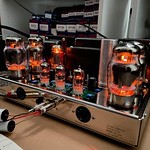corndog71 wrote:Instead of looking at how the preamp "improves" the sound, consider exploring how a fixed signal going into passive attenuator negatively affects the sound.
I can't tell if you are joking. Is this a serious question?

Dedicated to the restoration and preservation of all original Dynaco tube audio equipment - Customer support for Tubes4hifi VTA tube amp and preamp kits and all Dynakitparts.com products

corndog71 wrote:Instead of looking at how the preamp "improves" the sound, consider exploring how a fixed signal going into passive attenuator negatively affects the sound.

Dogstar wrote:...
I think that for anyone that thinks a preamp improves sound quality what it really is is that they like the way the tubes installed color the sound which is fine if you like that sort of thing.


corndog71 wrote:No, I'm serious. In my experience, going from a fixed source to an attenuator and immediately into an amp has consistently left me with two impressions:
1. Slightly better clarity and detail compared to the active preamp I was using at the time.
2. Dulled dynamics and somewhat less defined bass.
Now I admit these were just casual observations but I've tried this numerous times with different sources and amps and observed the same effects. So take it for what it's worth.
For me the improved dynamic swings in the music that came with the active preamp won the contest every time. I appreciated the clarity of the passive attenuator but if the music doesn't move me then what's the point?

solderblob wrote:I found a dB gain calculator on line. My Cornet phono pre has 44 dB gain. Add 10 dB for the step up transformer. 54 dB. My Denon DL103 has an output of 0.3 mV.
Using the calculator (which does dB = 20 × log (V2 / V1)) 54 dB results in a voltage multiplier of 501. So 0.0003V x 501 = 0.15V.
What am I doing wrong???
dave

rjpjnk wrote:It cannot possibly degrade the signal or remove dynamics.
corndog71 wrote:rjpjnk wrote:It cannot possibly degrade the signal or remove dynamics.
That is absolutely not true. Try comparing a cheap Alpha pot to a PEC pot or stepped attenuator with individual resistors. All 3 will sound different.
rjpjnk wrote:solderblob wrote:I found a dB gain calculator on line. My Cornet phono pre has 44 dB gain. Add 10 dB for the step up transformer. 54 dB. My Denon DL103 has an output of 0.3 mV.
Using the calculator (which does dB = 20 × log (V2 / V1)) 54 dB results in a voltage multiplier of 501. So 0.0003V x 501 = 0.15V.
What am I doing wrong???
dave
Looks correct to me. Why do you think it is wrong?

corndog71 wrote:rjpjnk wrote:It cannot possibly degrade the signal or remove dynamics.
That is absolutely not true. Try comparing a cheap Alpha pot to a PEC pot or stepped attenuator with individual resistors. All 3 will sound different.

solderblob wrote:
OK, I think I know what I did wrong. The SUT has a turns ratio of 15:1. That's not gain, it's voltage multiplication. That would nominally multiply the voltage by 15, not 15 dB gain (or 10 as I used before). So starting over:
0.0003V x 15 = 0.0045V. Putting 44dB gain for the phono pre into the dB gain calculator gives a 158 voltage multiplier. So 158 x .0045 = 0.71V.
My SUT also has a center tap which you can select to get 30:1 ratio. That would work out to 1.42V to the amp.
I've been listening with the SUT in the low 15:1 mode, but now after reading this thread, I think I use the 30:1 setting and maybe have a bit more headroom/dynamics.
dave
rjpjnk wrote:I just meant the math was right.
As far as which tap to use on the SUT it all depends on what range on input signal your particular amplifier requires. If it is a VTA amp I think the 0.71 is too low and the 1.42 is too high. If you are using a simple passive attenuator on the input to the power amp I'd go with the 1.42 and cut it down with the attenuator so at least you can reach full volume if you want to.
These are RMS voltages, right?

rjpjnk wrote:
I realize this puts me at odds with the millions of serious audiophiles paying thousands of dollars for extremely high end preamplifiers, (well, I'm already at odds. I bought Klipsch speakers) but until I hear any sound reasons otherwise, what else can I conclude? I will definitely keep an open mind and learn more about this special device as time goes on.
rjpjnk wrote: The input impedance of a VTA70 is on the order of 500KOhms, and its input voltage range is 1V rms.



audiobill wrote:Just weighing in -
In my system, using the SP14 adds a level of dynamic headroom, clarity and transparency beyond not using it. Not to speak of switching convenience.
And that's on top of using very high end input sources with superb analog stages of their own.
I was previously a skeptic, but this is my experience.

rjpjnk wrote:Haha, That question will be more than $64.00They do look nice though...
You know what's really funny? An active preamp being fed a line level signal actually spends most of its time reducing the signal level! That is, unless you are listening near full volume.

monkuboy wrote:I've tried source direct to my ST-120 using its attenuator, an Emotiva XMC-1, a Schiit Saga preamp, and the SP14. Logically I shouldn't need a preamp but I get the best results to my ears using the SP14. For me that was a totally worthwhile purchase.
monkuboy wrote:I've tried source direct to my ST-120 using its attenuator, an Emotiva XMC-1, a Schiit Saga preamp, and the SP14. Logically I shouldn't need a preamp but I get the best results to my ears using the SP14. For me that was a totally worthwhile purchase.